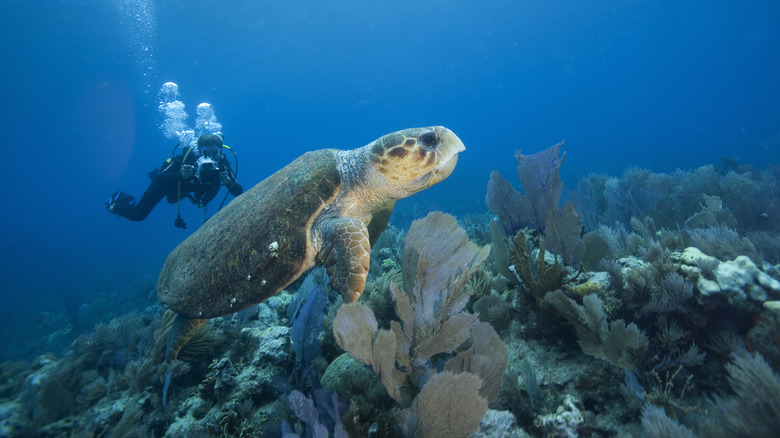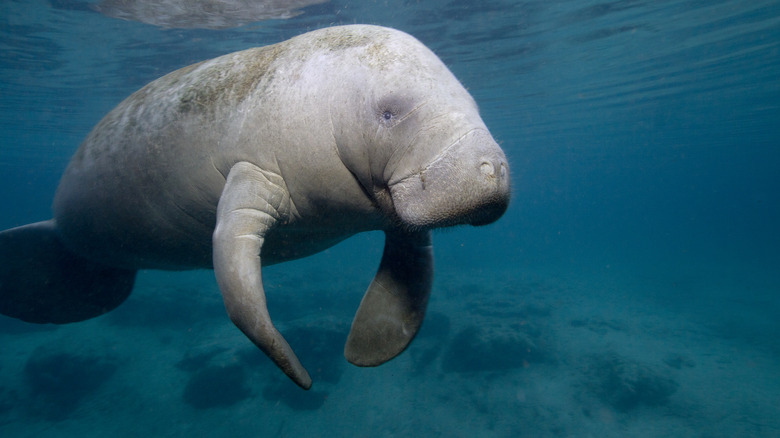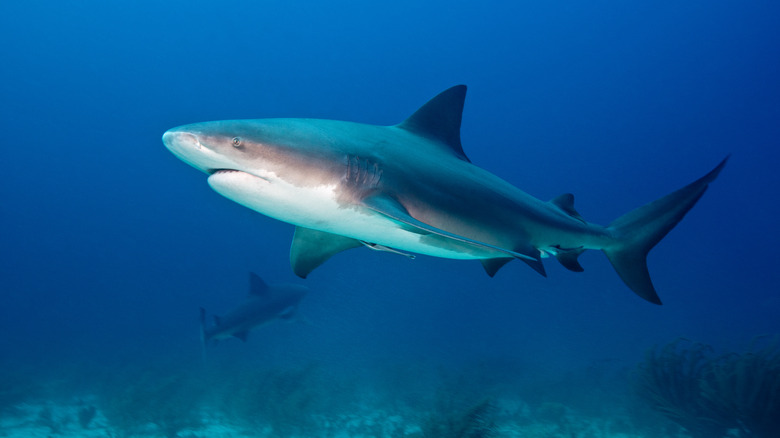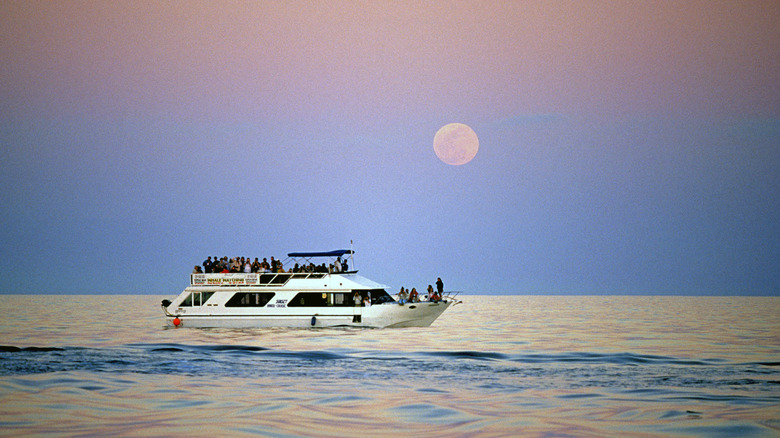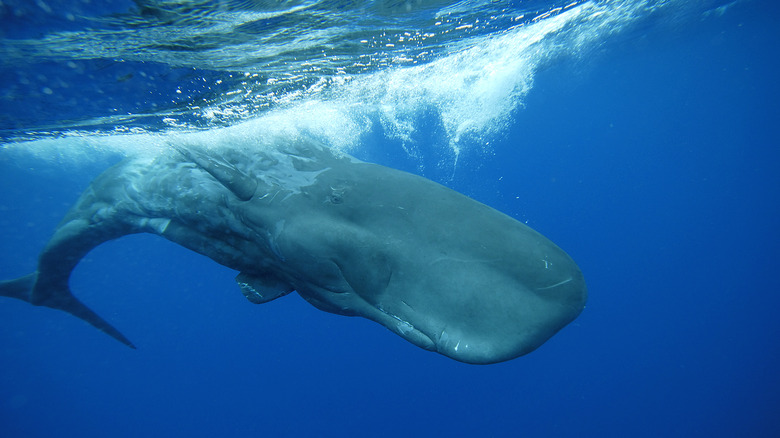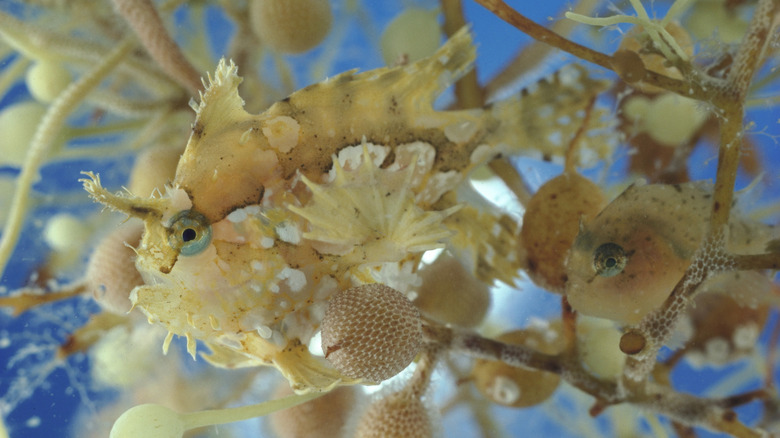Spectacular Sea Species In The Gulf Of Mexico
The Gulf of Mexico may be known for its warm waters, temperate climate, and beautiful beaches. However, this 218,000 square-mile ocean basin is also home to some of the most interesting sea species in the world. When considering both the environment and the economy, the Gulf of Mexico is also one of the most critical coastal regions of the U.S.
Just like many land creatures travel south to Gulf Coast states for the winter (including humans), some of the marine species in the Gulf of Mexico also migrate to the area during the cooler months of the Northern Hemisphere. But whether they live there or are just visiting, the species that inhabit the Gulf of Mexico's sensitive ecosystem include many unique fish, sharks, sea turtles, and dolphins, some of which you may not find anywhere else in the world. Here are just a few of those spectacular sea species that reside in the Gulf of Mexico.
Five types of sea turtle live in the Gulf of Mexico
Sea turtles are among some of the most graceful — and vulnerable — sea species in the world. Of all the seven species, six are considered endangered, and five of them can be found in the Gulf of Mexico. These include green, hawksbill, leatherback, Kemp's ridley, and loggerhead varieties. While it's possible to spot any of them in the Gulf of Mexico, the most common is the loggerhead turtle (Caretta caretta), and the rarest variety is the Kemp's ridley turtle (Lepidochelys kempii).
Loggerhead turtles have heart-shaped shells that are brown on top and pale yellow on the bottom, as well as large heads. Their average length is 3 feet, and they may weigh around 350 pounds as adults. Kemp's ridley turtles are the rarest variety, but they almost exclusively nest along the Gulf shores. All sea turtles in the Gulf of Mexico are protected under the Endangered Species Act.
Florida manatees inhabit all parts of the Gulf of Mexico
Manatees are unique mammals that are known as "sea cows" due to their large size, gentle nature, and plant-based diets. While there are technically three types of manatees in the world, a sub-type of West Indian manatee is the type you might encounter in the Gulf of Mexico. Also called the Florida manatee (Trichechus manatus latirostris), this species may be spotted all over the Gulf, including off the coasts of Texas and Louisiana. In Florida, these manatees can inhabit the warm waters of the Gulf, but may travel further inland to the state's rivers and springs during the winter months.
Many people who visit Florida hope to spot a manatee. Fortunately, they are not difficult to spot, as adult manatees can grow up to 13 feet long and over 3,500 pounds. Unfortunately, the greatest threats to these giant and gentle mammals are human-related. Among these include food and habitat losses fueled by climate change, as well as deadly injuries from boat collisions.
Bull sharks love the same warm shallow waters that humans enjoy
Bull sharks exist all over the world, but those found in U.S. waters are primarily located in the Atlantic and in the Gulf of Mexico. While technically classified as a fish, the bull shark (Carcharhinus leucas) is often found by itself rather than with others of its own species, although that changes during mating season. On average, bull sharks can live between 12 to 16 years and grow between 7 and 11 feet or more. Compared to other sharks, the bull shark has a higher width ratio, and it can weigh up to 500 pounds. You may also be able to distinguish a bull shark from other species by its dark colors on its upper body and lighter colors on the bottom.
This shark mostly eats fish, sharks, turtles, and mammals. However, true to its "bullish" name, the bull shark is even known to eat others of its own kind. The good news is that while bull sharks tend to prefer shallow waters and nearby rivers, which can put them in close proximity to humans, they are rarely known to attack. In fact, humans pose more of a danger to bull sharks via the fishing industry. They have a "near-threatened" status due to the effects of commercial fishing accidents, pollution, and habitat losses from climate change.
Several dolphin species reside in the Gulf of Mexico
If you're planning a dolphin sighting tour, there's a chance you may catch a glimpse of one of the several species that live in the Gulf of Mexico. In fact, it's thought that the Gulf is home to nine species of dolphins. These include the Atlantic spotted, bottlenose, Clymene, Fraser's, pantropical spotted, Risso's, rough-toothed, spinner, and striped varieties. Of all nine dolphin species, humans are more likely to see bottlenose and pantropical spotted varieties due to their tendency to hang out closer to the shore.
The common bottlenose dolphin (Tursiops truncatus) has a characteristic wide and short snout, ranges in length from 6 to 13 feet, and can weigh between 300 and 1,400 pounds. On the other hand, the pantropical spotted dolphin (Stenella attenuata) is much smaller and known for its spotted body. Weighing just 250 pounds on average and up to 7 feet long, pantropical spotted dolphins are also very social, so you're more likely to see them in groups. Like many other Gulf of Mexico residents, dolphins are at risk of human-related threats, such as boat strikes, oil spills, pollution, and the fishing industry.
Blacktip sharks are common in the Gulf of Mexico
There are numerous shark species that call the Gulf of Mexico home, with the Atlantic sharpnose shark considered the most common. However, you're far more likely to spot another common shark in the Gulf due to its presence in shallow coastal waters: the blacktip shark (Carcharhinus limbatus). Identifiable by black markings on the fins, blacktip sharks typically weigh over 100 pounds, can grow more than 6 feet in length, and are popular for the way they jump and whirl from the water. Blacktip sharks are sometimes confused with spinner sharks, and while the two shark species look similar at first glance, the best way to tell them apart is that spinners have a black marking on the anal fin, while blacktip sharks do not.
Blacktip sharks eat a variety of foods, including fish, shrimp, and smaller sharks. You may even spot them following fishing vessels in the Gulf from time to time in hopes of catching an easy meal. Also, due to their steady population and lack of overfishing, the blacktip shark is legal to catch with a valid fishing license in your state.
The Rice's whale is a newly recognized species in the Gulf of Mexico
For decades, scientists believed that Rice's whales were subtypes of Bryde's whales, which are found in tropical waters all over the world. However, genetic testing revealed that the Rice's whale is genetically distinct enough that in 2021, it was declared to be a new species (Balaenoptera ricei). Thought to be exclusive to the Gulf of Mexico, the Rice's whale lives mostly in the northeastern Gulf, although they have also been seen in the waters off the coasts of Mexico and Texas. Like other baleen whales, Rice's whales are massive, weighing up to 60,000 pounds and growing up to 41 feet long, mostly feeding on schooling fish species.
Currently, the Rice's whale is the only type of baleen whale that lives in the Gulf of Mexico year-round. Due to their extremely small population — believed to be just over 50 – Rice's whales have endangered status under the Endangered Species Act. Their biggest threats include the oil and fishing industries, vessel accidents, pollution, and military activities.
Several species of hammerhead shark live in the Gulf of Mexico
The hammerhead shark (Sphyrnidae family) is perhaps one of the most identifiable species of shark, with its characteristic flat, hammer-shaped head. While these sharks are found all over the world in tropical waters, many of them also call the warm waters of the Gulf of Mexico their home. In fact, there are three common species in the Gulf, including the great hammerhead, scalloped hammerhead, and smooth hammerhead. Another known species of hammerhead in the Gulf of Mexico is the bonnethead, which is the smallest of these sharks and only grows up to 4 feet long.
All hammerhead species tend to favor shallow waters as well as those near coral reefs, where they feed on species such as fish, squid, crabs, and smaller sharks. Also, don't let the appearance of hammerhead sharks fool you, as they can be dangerous to humans. In fact, out of all shark species, hammerhead sharks rank in the top 10 for unprovoked attacks on humans.
Parts of the Gulf of Mexico are also home to sperm whales
The natural habitat of sperm whales (Physeter macrocephalus) might be commonly thought to be mostly wide open seas, such as the Pacific or Atlantic Oceans. In fact, not only do these large whales also call the northern portions of the Gulf of Mexico home, they're the largest animal in the Gulf waters. While the exact population is unknown, recent estimates suggest there may be nearly 1,200 sperm whales in the northern Gulf, according to the National Oceanic and Atmospheric Administration (NOAA).
While you likely won't see them in shallow coastal waters, it is still possible to encounter sperm whales offshore, such as during diving expeditions. Experts also believe that most of the year-round Gulf sperm whale populations are female, as the males may travel to higher-latitude waters for more nutrients. They are considered the most common species of large whales in the Gulf of Mexico, and they are also endangered. Unfortunately, some of the key dangers to these fascinating whales include oil spills, the fishing industry, pollution, and vessel strikes.
The Atlantic horseshoe crab is an ancient Gulf Coast resident
The Atlantic horseshoe crab (Limulus polyphemus) is perhaps one of the most unique residents of the Gulf of Mexico. Horseshoe crabs can be found around the world, but the Atlantic horseshoe crab is found along the Atlantic and Gulf of Mexico coasts. While described as crabs, horseshoe crabs are technically arthropods that have ancestry dating back an astonishing 445 million years or more. These arthropods are primarily brownish and olive in color, with a large horseshoe-like shell and a long tail. In all, they can range in length up to 24 inches and weigh over 10 pounds.
If you're along the Gulf of Mexico, you may occasionally spot these horseshoe crabs crawling along the sand in shallow waters along the coast, and they may also come closer to shore during times of high tide. Its long tail also serves a purpose key to its survival by helping the horseshoe crab flip itself back on its feet if waves knock it over. Contrary to their sometimes intimidating appearance, they do not pose a threat to humans and will not "sting" you with their tails. In fact, humans are more likely to pose threats to these horseshoe crabs due to erosion, habitat losses, and the aquarium industry.
The sargassum fish lives in a habitat bearing the same name
Also known as a type of frogfish, the sargassum fish (Histrio histrio) is one of the most unusual-looking creatures in the Gulf of Mexico. They get their name from the notorious sargassum algae, a seaweed that blankets large parts of the Atlantic Ocean and travels across the sea to the southeastern, Caribbean, and Gulf Coast regions via wind and currents. Sargassum algae can be a nuisance as large quantities can stretch for several miles across the water and pile up on shorelines, but it is an important source of food and habitat for numerous sea creatures, including the sargassum fish.
It may be difficult to spot a sargassum fish in the wild because it closely matches the algae it spends so much time in. They are brown in color and have textured fins that blend into the sargassum algae around them. Interestingly, sargassum fish rarely swim, instead choosing to crawl and hop around seaweed. Humans don't usually eat sargassum fish, although they sometimes show up in pet stores or aquariums.
Manta rays are large creatures that enjoy warm Gulf waters
The manta ray is a large, diamond-shaped species with long tails that can be found in tropical waters around the world. This includes the Gulf of Mexico, which is home to both the giant manta ray (Mobula birostris) and reef manta ray (Mobula alfredi). As their name suggests, the giant manta ray is the largest of all manta rays, growing up to 26 feet long and weighing an astonishing 5,300 pounds. All manta rays have black coloring, while some also have white bellies and spots on top. While these fascinating creatures can be found both along the shore and in off-coast waters, they're also known to occasionally swim into bays and intercoastal waterways. They've even been reported near the Mississippi River during the spring and autumn months.
Manta rays can live more than 45 years old. For most of this time, they live in solitude and migrate to warmer waters throughout the year to forage for their diet of zooplankton. Unfortunately, they are also vulnerable to human activities, as well as accidental fishing and aquarium trading.
Stingrays are not the same as manta rays
Like manta rays, stingrays (Myliobatoidei) live in warm waters all over the world, including the Gulf of Mexico. They also have wing-like fins that help them glide through the water, as well as tails. However, the comparison between these two species pretty much stops there. While often mistaken for manta rays, stingrays are much smaller species, weighing nearly 800 pounds and measuring up to 6.5 feet. Stingrays are also more likely to inhabit shallow waters near coastlines, where they eat a predominantly carnivorous diet of shrimp and crabs, as well as oysters, mussels, and clams.
Another fact that sets the stingray apart from the much larger manta ray is its threat to humans. While stingrays don't deliberately attack humans, they can sting when they are threatened, and their tails contain both a sharp barb and deadly venom. For these reasons, if you go into the water in the Gulf of Mexico, it's a good idea to shuffle your feet in the sand to help scare off stingrays, lest you accidentally step on one and get stung.
The goliath grouper is among the largest fish species in the Gulf
True to its name, the goliath grouper (Epinephelus itajara) is the largest type of grouper in the Atlantic Coastal regions. This fish prefers warm, tropical waters, such as the eastern Gulf of Mexico. The goliath grouper is said to favor these shallow waters near the Florida Keys, as well as near the Caribbean islands. If you do come across a goliath grouper, there's no mistaking it for another species: adults can weigh up to 800 pounds and grow up to 8 feet long during a life span that can exceed 30 years. You can also identify the grouper with its olive to brown-colored body and lighter-colored stripes and spots.
The goliath grouper is a fascinating species that has also historically drawn the attention of fishers. However, due to overfishing, harvesting of the goliath grouper in the Gulf of Mexico was outlawed in 1990. The population has since rebounded and the NOAA decided not to add the goliath grouper to protected status under the Endangered Species Act in 2011. Nevertheless, the population growth is still delicate, and harvesting this grouper species is tightly restricted to a three-month period in Florida's waters.
Sand dollars are a common sea species along shallow Gulf waters
While their exoskeletons are often commonplace in Florida-inspired homes as decorations or souvenirs for people who visit the Sunshine State, sand dollars (Clypeasteroida) are living creatures that reside along shallow coastal areas such as the Gulf of Mexico. Contrary to popular belief, sand dollars are not shells. In fact, they are invertebrates that have small tentacle-like feet that help them move around as they eat zooplankton and phytoplankton along the sea floor. They range in size between 2 to 4 inches and weigh just 1 ounce on average. However, there have been reports of much larger sand dollars, such as those along the northwest Florida coast. Also, while you may be familiar with bleached exoskeletons in souvenir shops, live sand dollars actually range in color from pink to dark purple or charcoal.
If you're lucky, you may be able to feel them underneath your feet in the sand under the waves, but it's more common to find dead sand dollars washed up on shore, where their exoskeletons lay among shells. Sand dollars are not harmful to humans in any way, though some people do make the mistake of taking live sand dollars from the Gulf waters as souvenirs, not realizing they are more than just their outer layers. These small but mighty sea creatures are also prone to human-induced habitat changes, such as pollution and water acidification.

